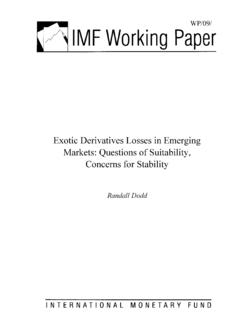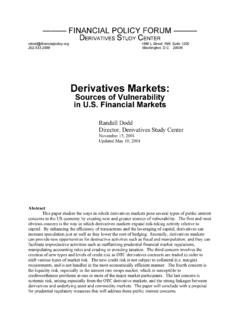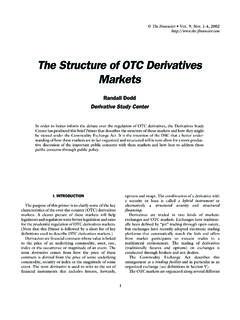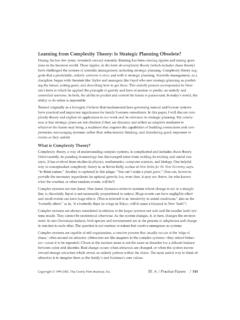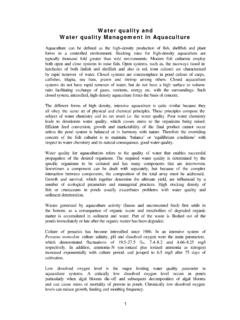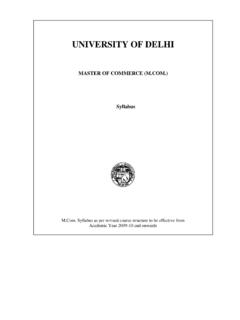Transcription of PECIAL POLICY REPORT 12
1 FINANCIAL POLICY FORUM DERIVATIVES STUDY CENTER 1660 L Street, NW, Suite 1200 Washington, 20036 SPECIAL POLICY REPORT 12 The Economic Rationale for Financial Market Regulation Randall Dodd Derivatives Study Center Washington December 2002 Executive Summary: This chapter will develop a theoretical framework that will serve as a positive theory for the appropriate type and degree of regulation in financial markets. The approach is based on the identification of imperfections (such as externalities, incompleteness, failures and asymmetries) in perfectly competitive or laissez-faire financial markets and analyzing how they result in inefficient or non-optimal outcomes. Included in this section is a discussion of the externality of risk, three types of externalities of information, destructive competition, natural monopolies and too-big-to-fail problems.
2 The next step is to explain how certain regulatory measures or government interventions can improve upon the laissez-faire market outcomes. The chapter concludes by showing how under more realistic assumptions about how markets actually operate that financial markets are more efficient, more stable and less likely to transmit disturbances to the overall economy if they are properly regulated. 1 INTRODUCTION In recent years, the POLICY debate over financial market regulation remains underdeveloped as it too often remains limited to a choice between complete deregulation or no change at all. This situation arises from a dominant economic theory that assumes perfect markets and concludes from them that a completely free market POLICY is best. Opponents, finding themselves without a coherent theoretical framework, fall back on a no change POLICY as their best defense.
3 In order to remedy this paralysis, this essay is designed to both elaborate a new theoretical framework and to propose a new set of regulatory standards. This theoretical approach is based on identifying the imperfections in financial markets and describing how they are contrary to the assumptions that underlie the conventional economic theory. These new and different assumptions then support different conclusions, namely that financial markets are more efficient, more stable and less likely to transmit disturbances to the overall economy if they are properly regulated. The framework also helps determine the most appropriate set of regulations. In the developing world, extreme free market policies towards financial markets created a new but not unfamiliar financial stumbling block to improved living standards and prosperity.
4 The economic failure arising from these POLICY errors put a crack in the Washington Consensus .1 Since that time a good deal of critical thinking has been focused on the international financial architecture and how to reform it. Most of the new thinking has focused its criticism of the policies of the International Monetary Fund (IMF) and the World Bank. Yet the role of national governments in regulating their domestic financial markets, including the role they play internationally, needs just as much attention. The mainstream economic theory, as it now stands, holds that an unrestricted or laissez-faire competitive equilibrium is the most efficient economic arrangement. This concept is known as Pareto Optimality where production and consumption cannot be reorganized or reallocated to increase the utility of one or more individuals without decreasing the utility of some other.
5 This theory is built upon assumptions that include: i) perfect (atomistic) competition where no individual or firm can exercise market power; ii) no externalities2 so that market prices reflect all private and social costs and benefits; iii) information is costless,3 so that consumers and investors are omniscient regarding market information; iv) no destructive competition; v) no incomplete markets or market failures; and vi) no national security concerns. Efficient Market Theory The idea of a perfectly competitive market was applied to financial markets, and especially securities markets, to produce the notion of efficient market theory or efficient market 1 ) The term Washington Consensus refers to the combination of laissez-faire neo-classical economic theory and the extreme free market ideology build upon it.
6 The term was coined, or the coinage is claimed, by John Williamson of the International Institute of Economics, in Williams, 1990. 2 ) Henderson, James M. and Richard E. Quandt. 1971. Microeconomic Theory: A Mathematical Approach, 2nd Edition. McGraw-Hill, New York. The conclusion that perfect competition leads to Pareto-optimal allocations is contingent upon the assumption that there are no external effects in consumption and production. 3 ) Again I quote the popular graduate textbook by Henderson and Quandt, A perfectly competitive commodity market satisfies the following (3) both firms and consumers possess perfect information about the prevailing price and current bids,. 2 One of the seminal authors of the theory, William Sharpe (1970), stated it as follows. Simply put, the thesis is this: in a well-functioning market, the prices of capital assets (securities) will reflect predictions based on all relevant and available information.
7 This concept holds that securities prices or more broadly all prices established in financial markets, fully reflect all the available and relevant information available to investors. There are many major implications that flow from this point. One is the notion that securities prices follow a random walk. If all relevant information is reflected in the current market price, then only meaningless noise is left to explain price movements. Another implication is that investors cannot systematically beat the market. If all relevant market information, including that about the present and the likelihood of the future, has been used to determine present prices, then any future change in price is unpredictable. Similarly, any price that does reflect the perfectly informed fundamentals will create the possibility of arbitrage profits and in turn arbitrage trading that will drive the price back the level reflecting informed fundamentals.
8 Yet another implication is that prices themselves represent valuable information. This was concisely stated in Stiglitz (2002, ) For more than 100 years, formal modeling in economics had focused on models in which information was assumed to be perfect. The POLICY implication of this laissez-faire economic theory is to justify a complete deregulation of financial markets. In the international context this generated the development POLICY known as capital account liberalization or neo-liberalism. Capital controls and many other financial market regulations were eliminated, and capital was allowed to flow unrestricted across borders. In many developing countries, the deregulatory effort ushered in a surge of foreign capital in the form of stocks and bonds, banking lending and a strong rise in foreign direct This extreme laissez-faire thinking, called free market fundamentalism by Joseph Stiglitz and others, was applied to national POLICY in the as well as in the developing world.
9 In the , it gave rise to a series of regulatory changes, chief amongst them were: the Gramm-Leach-Bliley Act of 1999 that partially repealed the Glass-Steagall Act requiring the separation of banking and securities activities; a deep and broad scale deregulation of derivatives markets by the Commodity Futures Modernization Act of 2000; and the rule promulgated in 1998 by the Securities and Exchange Commission known as Broker-Dealer Lite that lowered the capital requirements for derivatives dealers. The free market fundamentalism also put a stop to regulatory reform efforts that would have prohibited auditing firms from also engaging in consulting business with the same client. But what is perhaps most important is what was not done. Despite the recurrence of numerous and notorious failures associated with hedge funds, derivatives and sharp lending practices such as the promotion of sub-prime loans, there was no successful effort to remedy the costly consequences of these financial activities.
10 New Approach to Regulation In order that future financial market regulatory policies be directed by reasonable and thoughtful methods that seek the best for the public good, this chapter strives to provide a more critical analysis of the old approach and a more reasonably grounded framework for a new one. The 4 ) I will use the term efficient market theory rather than the latter. The best articulation is by Fama (1970) but other seminal articles include Fama (1965), Sharpe (1964), and Lintner (1965) . 5 ) A portion of the capital flows in the form of equity shares was deemed to be foreign direct investment if an investor held more than 10% of a firms outstanding shares. 3 approach is to identify inconsistencies between the actual characteristics of financial markets and the assumptions about these characteristics that serve as the foundation for economic theory.
